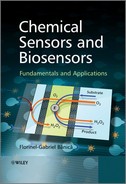Contents
Chapter 1: What are Chemical Sensors?
1.1 Chemical Sensors: Definition and Components
1.4 Sensor Configuration and Fabrication
1.8 Sensors in Flow Analysis Systems
1.9 Applications of Chemical Sensors
1.10 Literature on Chemical Sensors and Biosensors
Chapter 2: Protein Structure and Properties
2.2 Chemical Structure of Proteins
2.3 Conformation of Protein Macromolecules
2.4 Noncovalent Chemical Bonds in Protein Molecules
2.5 Recognition Processes Involving Proteins
Chapter 3: Enzymes and Enzymatic Sensors
3.2 Enzyme Nomenclature and Classification
3.3 Enzyme Components and Cofactors
3.4 Some Enzymes with Relevance to Biosensors
3.5 Transduction Methods in Enzymatic Biosensors
3.6 Kinetics of Enzyme Reactions
Chapter 4: Mathematical Modeling of Enzymatic Sensors
4.2 The Enzymatic Sensor under External Diffusion Conditions
4.3 The Enzymatic Sensor under Internal Diffusion Control
Chapter 5: Materials and Methods in Chemical-Sensor Manufacturing
5.2 Noncovalent Immobilization at Solid Surfaces
5.4 Supports and Support Modification
5.11 Entrapment in Mesoporous Materials
5.13 Microfabrication Methods in Chemical-Sensor Technology
Chapter 6: Affinity-Based Recognition
6.3 Immobilization Methods in Immunosensors
6.5 Protein and Peptide Microarrays
Chapter 7: Nucleic Acids in Chemical Sensors
7.1 Nucleic Acid Structure and Properties
7.3 Nucleic Acids as Receptors in Recognition Processes
7.4 Immobilization of Nucleic Acids
7.5 Transduction Methods in Nucleic Acids Sensors
Chapter 8: Nanomaterial Applications in Chemical Sensors
8.4 Polymer and Inorganic Nanofibers
8.5 Magnetic Micro- and Nanoparticles
8.6 Semiconductor Nanomaterials
Chapter 9: Thermochemical Sensors
9.3 Thermocatalytic Sensors for Combustible Gases
Chapter 10: Potentiometric Sensors
10.2 The Galvanic Cell at Equilibrium
10.3 Ion Distribution at the Interface of Two Electrolyte Solutions
10.4 Potentiometric Ion Sensors – General
10.5 Sparingly Soluble Solid Salts as Membrane Materials
10.6 Glass Membrane Ion Sensors
10.7 Ion Sensors Based on Molecular Receptors. General Aspects
10.8 Liquid Ion Exchangers as Ion Receptors
10.9 Neutral Ion Receptors (Ionophores)
10.10 Molecularly Imprinted Polymers as Ion-Sensing Materials
10.11 Conducting Polymers as Ion-Sensing Materials
10.12 Solid Contact Potentiometric Ion Sensors
10.13 Miniaturization of Potentiometric Ion Sensors
10.14 Analysis with Potentiometric Ion Sensors
10.15 Recent Advances in Potentiometric Ion Sensors
10.16 Potentiometric Gas Sensors
10.17 Solid Electrolyte Potentiometric Gas Sensors
10.18 Potentiometric Biocatalytic Sensors
10.19 Potentiometric Affinity Sensors
Chapter 11: Chemical Sensors Based on Semiconductor Electronic Devices
11.1 Electronic Semiconductor Devices
11.2 FED Ion Sensors and Their Applications
11.4 Schottky-Diode-Based Gas Sensors
11.5 Carbon-Nanotube-Based Field-Effect Transistors
Chapter 12: Resistive Gas Sensors (Chemiresistors)
12.1 Semiconductor Metal Oxide Gas Sensors
12.2 Organic-Material-Based Chemiresistors
12.3 Nanomaterial Applications in Resistive Gas Sensors
12.4 Resistive Gas Sensor Arrays
Chapter 13: Dynamic Electrochemistry Transduction Methods
13.2 Electrochemical Cells in Amperometric Analysis
13.3 The Electrolytic Current and its Analytical Significance
13.4 Membrane-Covered Electrodes
13.6 Kinetics of Electrochemical Reactions
13.9 Catalysis in Electrochemical Reactions
13.10 Amperometric Gas Sensors
Chapter 14: Amperometric Enzyme Sensors
14.1 First-Generation Amperometric Enzyme Sensors
14.2 Second-Generation Amperometric Enzyme Sensors
14.4 Conducting Polymers in Amperometric Enzyme Sensors
14.5 Direct Electron Transfer: 3rd-Generation Amperometric Enzyme Sensors
14.6 NAD/NADH++ as Mediator in Biosensors
Chapter 15: Mathematical Modeling of Mediated Amperometric Enzyme Sensors
15.1 External Diffusion Conditions
15.2 Internal Diffusion Conditions
Chapter 16: Electrochemical Affinity and Nucleic Acid Sensors
16.1 Amperometric Affinity Sensors
16.2 Electrochemical Nucleic Acid-Based Sensors
Chapter 17: Electrical-Impedance-Based Sensors
17.1 Electrical Impedance: Terms and Definitions
17.2 Electrochemical Impedance Spectrometry
17.3 Electrochemical Impedance Affinity Sensors
17.4 Biocatalytic Impedimetric Sensors
17.6 Nucleic Acid Impedimetric Sensors
17.8 Impedimetric Sensors for Gases and Vapors
Chapter 18: Optical Sensors – Fundamentals
18.1 Electromagnetic Radiation
18.2 Optical Waveguides in Chemical Sensors
18.3 Spectrochemical Transduction Methods
18.4 Transduction Schemes in Spectrochemical Sensors
18.5 Fiber Optic Sensor Arrays
18.6 Label-Free Transduction in Optical Sensors
18.7 Transduction by Photonic Devices
Chapter 19: Optical Sensors – Applications
19.1 Optical Sensors Based on Acid–Base Indicators
19.4 Optical Enzymatic Sensors
19.6 Optical DNA Sensors and Arrays
Chapter 20: Nanomaterial Applications in Optical Transduction
20.1 Semiconductor Nanocrystals (Quantum Dots)
20.2 Carbon Nanotubes as Optical Labels
20.3 Metal Nanoparticle in Optical Sensing
20.5 Luminescent Lanthanide Compound Nanomaterials
Chapter 21: Acoustic-Wave Sensors
21.2 The Thickness–Shear Mode Piezoelectric Resonator
21.3 QCM Gas and Vapor Sensors
21.6 Surface-Launched Acoustic-Wave Sensors
Chapter 22: Microcantilever Sensors
22.1 Principles of Microcantilever Transduction
22.2 Measurement of Cantilever Deflection
22.3 Functionalization of Microcantilevers
22.4 Microcantilever Gas and Vapor Sensors
22.5 Microcantilever Affinity Sensors
22.6 Enzyme Assay by Microcantilever Sensors
22.7 Microcantilever Nucleic Acid Sensors
Chapter 23: Chemical Sensors Based on Microorganisms, Living Cells and Tissues
23.1 Living Material Biosensors: General Principles
23.2 Sensing Strategies in Living-Material-Based Sensors
23.3 Immobilization of Living Cells and Microorganisms
23.4 Electrochemical Microbial Biosensors
23.5 Optical Whole-Cell Sensors
